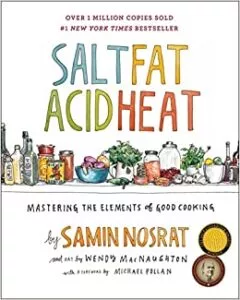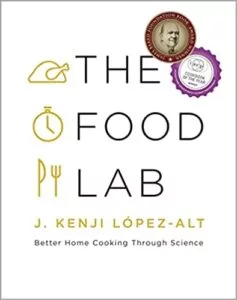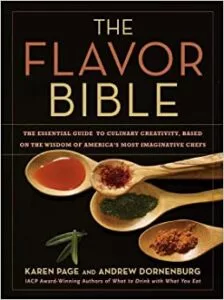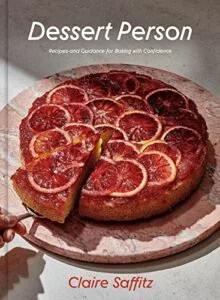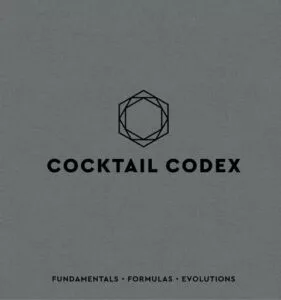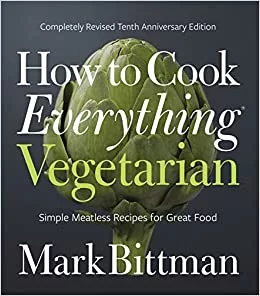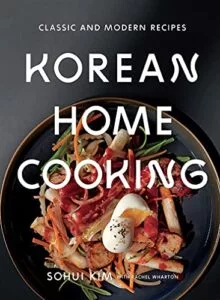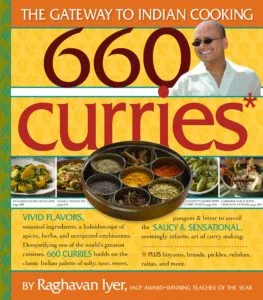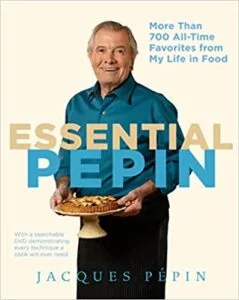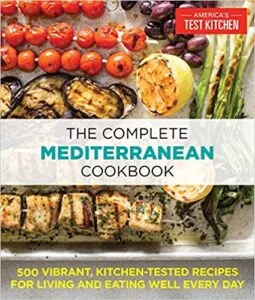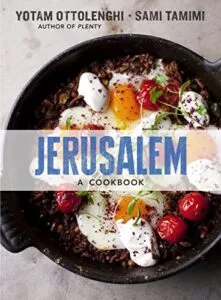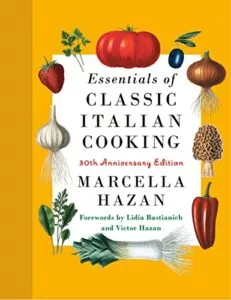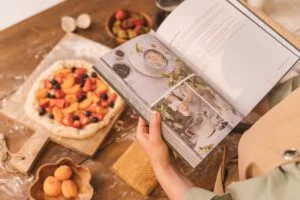
The Best Cookbooks You Can Find in Canada
Nobody starts off great at anything. This rings true with cooking especially – you could ask all the chefs in this article that and they would tell you the same thing. It can be hard to always have the physical and mental capacity to cook and prepare meals. However, being better at cooking definitely makes it easier to cook for yourself – and is the best way to eat healthier for less.
While there are more ways than ever to learn new recipes, the recipe book stands tall as a great resource for all: more recipes to learn from, no scrolling on a phone screen mid-recipe, and large-size pictures (often with glossy pictures).
The essentials for developing your skills
The best cookbook for changing how you think about cooking
Salt Fat Acid Heat
Samin Nosrat, 2017
Salt Fat Acid Heat was a text that made waves when it came out in 2017, as an incredibly helpful guide that simplifies cooking down to its essential parts and main reactions. By focusing on the four titular elements of each dish, with a “Anyone can cook anything” perspective, this is an incredible book that can boost your culinary background and expose you to new recipes and ideas, becoming a better chef along the way. And its watercolour art-style is wonderfully offbeat.
The four titular components: Salt, Fat, Acid & Heat, are introduced in this book as the four considerations that anyone should consider before cooking – with a recipe, and without. “The rest are a combination of cultural, seasonal, or technical details, for which we could consult cookbooks and experts, histories, and maps” Nosrat writes. Her discovery of these four building blocks of all cuisine, which proved universal through her career through the west coast of the US to Florence, Italy and back, also came with an equally important revelation: why is this knowledge held by every chef knows not out there for beginners to learn?
Cue Salt Fat Acid Heat, where Nosrat explains these four delicious variables at length so you can understand how they impact your cooking. Over the first 200 pages are what we would call “approachable theory”. Nosrat discusses the four key topics at length, imparting important lessons of cooking in a non-complex, non-pretentious way. All you will likely need is some recollection to Jr. High Science class for some of the food science information, but Nosrat does an excellent job of simplifying these terms and concepts.
Chapter 1 discusses salt, the importance of seasoning food, the impact time has on salting food, and countless techniques for how to know when your food is properly salted. Chapter 2 discusses fat, how the importance of oil and fat surpass just stopping things from sticking, the different types of fats and how you may use different types of fat or fat-rich products, and how to buy the right oils for your kitchen. Chapter 3 discusses acid, how acid excites tastebuds and elevates other flavours, the types of acids commonly used in cooking, how acid chemically changes ingredients, and how to leverage that in your cooking. Chapter 4 discusses (surprise, surprise) heat, but the heat of the grill or oven, not the heat of a pepper. This chapter dives into the chemical processes that occur when cooking different kinds of foods, the sensory aspect of these chemical changes so you can make sure that you are not over or undercooking, and the different methods of cooking we use worldwide. By the time you are done these four chapter, you will have a fuller understanding of what happens every time you cook, and will be a better cook for that.
The back half of this book features a host of further advice, from a kitchen basics section to instructional drawings that break down techniques from dicing an onion to pureeing garlic on your cutting board. And then finally, the subject of the article: the recipes. Nosrat’s recipes are simple, thoughtful, and endlessly customizable, with instructions how to take your dishes across the world with just a few ingredients.
Overall, it’s very easy to see why Salt, Acid, Fat, Heat has taken its place as a modern bible for learning how to cook. It’s foodie philosophy, made fun yet non-pretentious. The amount of knowledge wrapped up by the book’s binding is impressive. For non-cooks learning, it is inviting and simple enough for this to be an impactful book. For even experts, there’s so many exciting recipes you can try to make or improve upon.
The best food science guide
The Food Lab
J. Kenji López-Alt, 2015
The Food Lab from cooking guru J. Kenji López-Alt has cemented itself as a modern-classic in the cooking world, pairing encyclopedic knowledge and Kenji’s scientific curiosity with delicious recipes straight from the Test Kitchen. But if the contents section of this book and its explicit repetition of the word “science,” take solace in the book’s easy-reading, naturally funny style and non-pretentious way of breaking down food into its raw ingredients and cooking techniques.
The central concept of The Food Lab is to ask why certain ideas and practices are used in the Kitchen, using science to interrogate these long-held cooking myths like “searing meat locks in the juices”. Since Lopez-Alt has a “question everything” approach, classic recipes are inevitably broken down like a whole chicken, trimmed of the scraps of antiquated knowledge and seasoned with a little of the scientific process. The results are recipes that are not just delicious but analyzed and explained. It’s the type of book that just by reading it, you should become a little bit more apt in the kitchen.
So, what does Kenji offer in this book? Aside from a lengthy introduction (seemingly designed to evoke curiosity), Kenji starts from the basics: There’s section on the importance of quality cooking equipment, including details on topics like caring for cast-Iron pans and woks, instructions with visuals on techniques from the pro kitchen like knife handling and sharpening techniques, tips on food storage and kitchen organization to reduce time and food waste when you are cooking.
Once you get to sections on each food, Kenji breaks down a handful of ingredients, like the first chapter on Eggs – which starts with a generous Q&A, explaining everything you might have wondered about eggs – whether that be their biological make-up, what the difference between different “types” of eggs you might see in the grocery store, or what the exact time you need for your perfect boiled egg.
When you get to the recipes, Kenji gets to the details, using highly-descriptive language to serve as benchmarks for progress. While there’s plenty of musings about his history with certain foods earlier in this book, Lopez-Alt knows restraint and does not bog down the recipes with fluff. Not only are the recipes easy to follow and thorough (with advice and Q&A’s so you can learn when things go wrong) but the recipes are GOOD. Kenji’s Hollandaise recipe with the immersion blender has made the French sauce not just accessible for the home chef, but easy – and still impressive enough that I managed to impress my now-partner the first time I cooked for them. Other sections in this book that Lopez-Alt gets into the nitty gritty science of include stock, fast-cooking cuts of meat, vegetables, ground meat, roasts, pasta, salads, and frying, in that order. Lopez-Alt only shares areas of his expertise, and he admits that his baking and dessert knowledge is limited and not worthy of the criteria of expertise he holds for this book.
This book is great for any burgeoning foodie, from those who live in the kitchen, to those who are still learning their way around a knife. Kenji expertly combines food science and quality recipes in a way that’s not overwhelming, dry, or confusing. If you want to improve your cooking skills, you could probably do that just by reading this book.
The best flavour pairing reference book
The Flavor Bible
Karen A. Page & Andrew Dornenburg, 2008
The Flavor Bible is unlike other books on this list – rather than a compilation of recipes and the stories and processes behind them, it is a compilation of flavour pairings. It is a self-described “empowerment tool” to help chefs of all skill levels find flavours but perfect for whatever else you are cooking. Throughout this book, the authors discuss how some of the most established chefs of the states and the world build the flavour in their dishes. There’s a lot of food philosophy, but also food science, food culture, and food history included too.
Chapter 1 discusses the language of food – teaching about how culinary professionals talk about flavour and how you can use this language to think about food. Topics covered in this first chapter touch upon which types of tastes are picked up by your tastebuds versus your nose, defines foody words like mouthfeel, and gives names to sensations in the mouth you didn’t even realize had names. Importantly, the book/chapter discusses at length how a lot of the pleasure we derive from food is not entirely related to the physical food, but also the cultural, the spiritual, and the mental realms that can elevate a dish past the materials on the plate.
Chapter 2 takes the knowledge presented in Chapter 1 and lets you expand it into creating meals and flexing your creativity how some of the most prestige chefs in the world do. The chapter is devoted to explain the essences of moment – the occasion of cooking, the time and money constraints you may have, even the weather plays into how to perfectly capture the moment -and the essences of ingredients – what the ingredients you use will invoke, how they actually taste versus how stereotype the ingredients to taste, how they sit with us after the meal and impact our desire to eat more. This chapter’s philosophy on cooking really opens eyes in regard to how you can understand what chefs mean when they say their “food tells a story”.
The rest of the book is the real meat and potatoes: The Flavor Matchmaking charts list different cuisine and ingredients and what they naturally pair with other ingredients. The list is comprehensive – a passionate chef can really get lost in the possibilities! The chart feels comprehensive (including several ingredients I have never heard of!) but is laid out simply, with a chart of flavour, seasonality, and applicable techniques for preparation, and the “Flavor Affinities” section at the end of each chart highlights how the above ingredients can pair in complementary ways.
Recipes are not actually provided – instead a list of dishes that showcase a certain ingredient are listed, but not explained. It seems right along this book’s philosophy that you would be beckoned to try to make the dish itself, or look up a recipe outside of the book than provide you with step by step instruction. In many ways, this approach can be way more rewarding to those who want to step up their cooking game and really express themselves in the kitchen. Anyone from burgeoning home cooks to established chefs can and does use the Flavor Bible to explore flavour combos that might have eluded them.
The best cocktail recipe book
The Cocktail Codex
Alex Day, David Kaplan, Nick Fauchald with Devon Tarby, 2018
While on paper, gastronomy and mixology are close cousins, in practice they feel totally distinct. Different ingredients, different techniques, different groundwork to build from and most importantly, different experiences when consuming. The best source for burgeoning bartenders to learn the classics and beyond is The Cocktail Codex. A collaboration between four NYC bartenders, The Cocktail Codex is a great way develop your repertoire of drinks, expanding out from high-balls and learning the classics and beyond.
The Cocktail Codex looks at cocktails not by “families” of different cocktails as many fledging bartenders are instructed, but instead of a series of “intuitive progressions” that rise from the templates of some classic cocktails. These cocktail templates – The Old Fashioned, Martini, Daiquiri, Sidecar, Highball, & Flip – provide the basics you will need to understand how delicious drinks are formed, and what you can do to alter and change them into your own creation. From the author’s words: “the book aims to teach both novice and accomplished drink makers how to master a half dozen iconic cocktails – and invent new ones”.
In each of the book’s chapters, a cocktail is examined, with comparisons of the original recipe and a modern refined version provided by the mixologists. Then, they analyze the characteristics and components, looking at the core components of the cocktail, which ingredients are included to add some balance to the drink, and which ingredients add contrast or “seasoning” to the drink. In these sections alternative ingredients and specific bottles are recommended. Everything from the agitation method to drinkware is covered in detail.
Throughout the book, words of advice and inspiration from bartenders of various acclaimed watering holes across the U.S. help familiarize yourself with the names and ideas of current mixology. Between the thoughtful recipes and the amount of insight added into this book, someone who has never had a cocktail before can get a strong foundation for knowing, making and drinking cocktails from this book alone.
The best vegetarian cookbook
How To Cook Everything Vegetarian
Mark Bittman, 2007
How to Cook Everything Vegetarian is a follow-up to Mark Bittman’s seminal text How to Cook Everything (1998), zeroing on plants and all things vegetarian. While Bittman’s recent recipe books have touched more on vegetarian and vegan recipes, we like How to Cook Everything Vegetarian since it’s such a complete, thorough book packed with countless recipes.
Bitten approaches the Vegetarian edition of his How to Cook Everything series with the goal to build-up the fundamentals. This recipe book is broken into 14 different chapters, touching on classic categories (as broken down later). An example of how this book tackles the fundamentals is found in chapter 1 – ingredients – where Bittman gives helpful advice ranging from “8 ingredients that must be genuine” to “21 ingredients you really need”. As someone who always seems to run out of the essentials when I need them, these lists have really helped my grocery shopping habits.
The following chapter, based on has advice articles including, “three knives you must have,” “how to season cast iron,” and the “5 pots and pans you need”. Another helpful section – Techniques – introduces us to the basics that you need for cooking including how to hold a chef’s knife and use it, how to deep fry safely, and how to substitute animal-based products with vegan replacements.
The remaining chapters focus more on the recipes than techniques: a chapter on Salads, from fresh salads to grain salads and everything in-between; a chapter on Soups, starting with how to make homemade vegetable-based stocks, and developing into classics; a chapter that discusses those foods that separate the vegetarians from the vegans: Eggs, Dairy and Cheese and the best vegetarian dishes you can make with them; a chapter that dives into Produce; a chapter on Pasta dishes that don’t miss the meat; a chapter on Grain dishes; a chapter on the best ways to leverage that precious protein from Legumes; a chapter on replicating burgers with tofu, seitan, and other plant-based products; a chapter other sandwiches and other dough-based products including bread and pizza; a chapter on sauces comes before Bittman finalizes with a chapter on desserts, as you would.
The recipes in the book are provided in basic language, requiring techniques of admittedly varying difficulties. One thing I appreciate about these recipes is the relative simplicity of them, with ingredient lists that are not overly complicated or include too many ingredients you will not have.
Overall, from our research into cookbooks, we found that Mark Bittman’s books are never really misses. While there might be better books of his to choose from, but you could realistically choose How to Cook Everything Vegetarian for anyone who likes cooking, and they will find something they want to cook.
The best Korean cookbook
Korean Home Cooking: Classic and Modern Recipes
Sohui Kim & Rachel Wharton, 2018
Korean food is so many things. It can be sweet, spicy, sour, savoury – or any combination of the above! Just a few humble ingredients – “in our case chile paste, soybean paste, soy sauce, rice wine vinegar, sesame oil, and seasonal vegetables, to name but a few” – combined in different ways with different methods, can create whole new worlds of flavour.
Korean Home Cooking: Classic and Modern Recipes , a collaboration between Brooklyn NY chef and restaurateur Sohui Kim and cookbook author Rachel Wharton, offers both homestyle classics and modern takes on all things Korean, proving a perfect starting point for learning how to cook Korean food, learn to cook through Korean food, or learn a new recipe or take on a favourite.
One of my favourite parts of my local Korean restaurant’s experience is the small plates of Banchan provided before the meals come. So, I am happy that Chapter 1 of Korean Home Cooking features a list of Banchan recipes–small dishes that are served as accompaniments to main dishes. From Jorim to Kimchi, the preparation of these small sides instantly improve any of the other meals in this book.
Each recipe features gorgeous photography, often of the final results, but for more involved recipes involving different steps (including the Kimchi recipe) each stage is carefully depicted so you can follow along easily.
Next, Kim dives into the mouth-watering world of Korean Barbeque. As opposed to the “low and slow” cooking style of American barbeque, Korean Barbeque is about cooking thin cuts quickly over high-heat, preferably over live coals, but over anything from grills to stoves. This section does not spare any detail, down to trimming and butchering advice, with pictures to help. Since some of these cuts are non-traditional for North American butchers, this advice is very helpful, however you will more likely be able to find places selling cuts for Korean BBQ like Korean shortrib called kalbi. Still, props on Sohui and Wharton for going so in-depth.
Seafood and meat are the topics of the following section – Haesanmul & Gogi. These recipes differ in cooking style from the Barbeque section, including deep and shallow frying, broiling, and even raw preparations. Recipes included in these sections include spicy marinated crab, Korean fried chicken, and Bulgogi.
The next section focuses on Korean soups and stews including Guk, Jjigae, Jjim & Tang. Often served with rice, these soups and stews are true comfort food. From the beef and radish soup Sogogi Mooguk at the beginning to the master stocks included at the end of this chapter, this chapter is loaded with heartwarming, incredible broth.
The next chapters focuses on Myeon, Bap & Mandu – Noodle, Rice & Dumpling dishes, comprising of some of the most authentic Korean staples. Udon noodle soup, black bean noodle Jjajang Myeon, vegetable Japchae, Bibimbop, Fried rice, Tteokbokki – it’s a stacked class of all of my personal Korean favourites.
Finally, the last section of the book like the last part of any great meal – Hu-shik, or dessert. Korea is home to some of the greatest desserts in the world, and while this book does not have an extensive dessert section, the choices are varied and offer different offerings to appeal to different kinds of sweet tooth.
Korean Home Cooking is a thoughtful book with excellent advice and images. Kim’s collection is authentic and the recipes are presented simple when the recipe is simple, and presented thoroughly when they are complex.
The best Indian cookbook
660 Curries
Raghavan Iyer, 2008
660 Curries is a book filled with 660 Curry recipes. But it is also a lot more. It is one of the most thorough books on the cuisines throughout and around India I have encountered. Chef and Author Raghavan Iyer – winner of the 2004 Cooking Teacher of the Year – delivers this comprehensive book on the dish almost all of us think about when we think of India and the surrounding South Asian nations.
The first section of note features spice blends and pastes that pack the flavour from all over India. It offers helpful advice on how to get the most from your dried spices – in both flavour and lifespan – including buying full spices when you can and storing these spices only in airtight jars. Since Indian food is so reliant on the vibrant palette of spices that makes up most curries, this attention to spices and their combinations is a strong starting point to learn how to make delicious curries.
Once Raghavan lays the framework of spices down, he introduces us to the world of making curries. The bulk of the book – broken down by chapters – introduces curries or adjacent dishes by ingredient and builds up complexity or different flavours from page to page. While the skills and knowledge presented isn’t ordered in a necessarily linear way, if you start working your way through the book’s recipes, your curry cooking skills will improve as you become familiar with the reoccurring techniques and ingredients.
The sections are highlighted curries in the book include appetizer curries and other appetizers to serve alongside curry; poultry, game & egg curries; beef, lab & pork curries; fish & seafood curries; paneer curries; legume curries; vegetable curries; contemporary curries; biryani curries; and curry cohorts, which include the rice dishes, grilled breads, and accompaniments that complete a dinner. Overall, there’s everything you will need to make a feast full of curries!
The best French cookbook
Essential Pepin: More Than 700 All-Time Favorites from My Life in Food
Jacques Pepin, 2011
When a chef can name their cooking book after themselves the way Jacques Pepin can, you should listen. Pepin is a legend of French cuisine, who has focused on the educational and authorial aspects of his profession for much of his career.
For starters, this book is excellently laid out – each comprehensive section features its own (table of contents) section, so finding that specific recipe is extremely easy. The sections of recipes are diverse and organized by the role of each recipe in a meal – from wonderful side dishes or mains in the Pasta, Rice, Grains and Potato section, to a range of show-stopping centrerpieces in the Shellfish & Fish, Poultry & Game, or Meat sections. Essential Pepin does not offer a dessert section. Instead, it offers five.
While it may not be the most accurate description to call this book entirely French – Pepin looks to cuisines all over the world to inspire the dishes: from across Europe to Asia, there are diverse recipes for whatever you might be fiending for. However, French techniques and flavours are predominantly featured.
Essential Pepin is one of our favourites recipe books out there, but that’s also all it is. It does not dive into the science of cooking nor the culture behind the dishes. It does not offer detail into technique, but a basics section does help flesh out some of the recipes behind the recipes. If you are looking for a more technical cookbook from the master, we recommend New Complete Techniques, which Pepin penned the year after Essential Pepin.
The best Mediterranean cookbook
The complete Mediterranean cookbook: 500 vibrant, kitchen-tested recipes for living and eating well everyday
Editors of America’s Test Kitchen, 1996
It is said that the Mediterranean diet is one of the healthiest in the world. While all the different cultures and cuisines that make up the Mediterranean stretch from North Africa, The Middle East, and Europe, some of the healthiest, easiest, and tastiest foods on the planet. So, when the talented chefs at America’s Test Kitchen came together to compile five hundred Mediterranean inspired recipes and classics with a focus on health as much as flavour, and you can see why this book is still held in such reverence, over 25 years since it’s release.
The book’s concept relies on the Mediterranean Pyramid, a concept developed jointly by Harvard School of Public Health and the World Health Organization in the 90’s, which studied how various people situated among the Mediterranean Sea were healthier, with lower incidences of diseases like Heart Disease. Researchers linked the health to the diets of those who lived in the Mediterranean during the mid-20th century, which focused heavily on fruits, vegetables and grains, serves fish more often than poultry and poultry more often than red meat, and serves it all with the godly nectar that is Olive Oil.
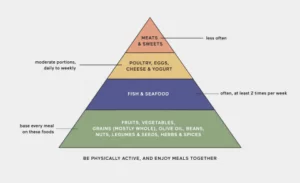
Graphic by mbg creative / mbg creative
Unlike other, flawed triangle-shaped models that aged poorly since the 90’s, the Mediterranean Pyramid can still be a good guideline to follow, as it is flexible and many of the core ideas it was based on hold true. Rather than cut out fats entirely, this diet proposes the use of healthier fats. However, it is important to note that since there are no portion guidelines recommended in the Mediterranean Pyramid, you still need to eat the right amount of foods, as the large amounts of healthy fats associated with can add up if you don’t take careful consideration of portion size
The recipes included in this book range from cultural staples of the peoples of the Mediterranean to innovative reimagining of some Mediterranean staples. The books promises to avoid ingredients not actually native to the region, so you won’t find Salmon or Quinoa in this book.
So, how are the recipes, you might be wondering. Overall, they are detailed, providing insight into why certain techniques or ingredients are called for, and what you should be looking for in each recipe. At the outset of each chapter, recipes are organized, with little bright squares indicating if the recipe if “a fast meal” or vegetarian. Recipes often start with the very basic iterations, with optional advice for some traditional or exciting variations. Breaking up sections of recipes are short insights into ingredients you might not be familiar with or that might need some knowledge to source and prepare correctly. While not as detailed as some books we’ve come across, the directions found inside are succinct and straightforward, so they should be very easy to use, granted you do have some experience in the kitchen. Some of the language or description used is not the most intuitive for a green chef. However, that is not to say we do not recommend this book for beginner chefs – there’s so many easy recipes that it’s hard not to recommend this.
Best guide for middle eastern food
Jerusalem: A Cookbook
Yotam Ottolenghi, 2012
The middle east is a region packed by diverse, interesting cultural dishes that can broaden one’s horizon. While nations including Iran, Turkey and Lebanon have food cultures too rich to overlook, the one book that people online could not stop talking about is Jerusalem: A Cookbook by Ottolenghi. Born from his upbringing in the titular streets, Jerusalem is a fascinating look of all the different flavours from across the world and how this flavor impacts the food of the city.
Jerusalem is a place of diversity, as people of all over the world have settled in within the city’s borders, and thus the cuisine to the region take influence from all over the world. Heck, even different regions of the city boast different flavours.
Ottolenghi’s Jerusalem features sections that dial in on the whole scope of cooking common in Jerusalem, from Vegetables, Beans & Grains, Soups, and Stuffed Foods, to Meat, Fish, Savory Pastries, and Sweets & Desserts. Each recipe features a story from within the city, context on an ingredient, the background of the friends and family of the authors and how this specific recipe came to be. With some books, this kind of light reading drags out the recipes and seems to gatekeep the truly important part of the book, but this cook book balances these short excerpts with a careful layout. These excerpts are often illuminating of the culture of Jerusalem, from food culture and beyond.
Best Italian cookbook
Essentials of Classic Italian Cooking
Marcella Hazan, 1992.
Italy offers us some of the best eating experiences – pizza, pasta, risotto and more all originate from the country shaped like a high-heeled boot. However, ask any Italian who makes the best Italian food, and the answer will be someone in the family. For a cookbook that gets you close to that homestyle Italian cooking, we recommend Essentials of Classic Italian Cooking by Marcella Hazan.
From the jump, Hazan breaks down common techniques and ingredients common on Italian cuisine, discussing the regions and their impact on the larger scale of Italian Cuisine. Next, she covers some of the essential components like mayonnaise or bechamel, or other common Italian sauces, are explained and broken down – introducing us to the foundations of some of our favourite classic Italian dishes. Next, Hazan discusses the equipment found in any Italian kitchen.
After these first eighty or so pages that establish the basics, Hazan gets into the meat & potatoes of the book: recipes (many of which involve acutally either meat or potatoes). Hazan guides us along a journey starting with the classic appetizes from throughout Italy, from plate of marinated fish & vegetables to Bruschetta (did you know that this dish is referring to the garlic bread – I didn’t). Next, Hazan dives into Italian soups, like the classic Minestrone as well as other staples throughout Italy.
Just like how Italian’s eat their dinner, following the appetizer courses in this book is the pasta chapters – with instructions on preparing fresh pasta yourself, and building fresh, flavourful sauces to match with them. A following chapter with techniques on achieving the perfect risotto naturally follows, as well as a chapter on polenta too.
The bulk of the middle chapters focuses on protein-based dishes from breakfast to secondi – starting with one of my favourite egg dishes in the Frittate, and followed with chapters on Fish & Shellfish, Chicken & Game, Veal, Beef, Lamb, Pork and Variety Meats. Need an accompaniment for those protein dishes? Check the next chapter on Vegetables for classics like Gratineed Aspargus & Eggplant Parmesan.
Finally, finish the dinner off with one of Italy’s delicious desserts – including semolina pudding, chocolate mousse, gelato of all different flavours – that’s enough of a reason to buy this book as any.
Hazan’s essentials provide an extensive look at all kinds of Italian cooking, and as a result, this book is long. However, while this book contains a lot of delicious recipes with varying degrees of complexity, there are a few criticisms that we have of this book. For starters, images in this book are limited to hand drawn images and are sparse. While not every cookbook needs those big, glossy pictures, having pictures for some more dishes would make this a more inviting book for beginner chefs. However, since Italian cuisine is so well loved, it’s hard not to include such an impressive collection of recipes.
The best baking book
Dessert Person: Recipes and Guidance for Baking with Confidence: A Baking Book
Claire Saffitz, 2020
Claire might be familiar to you – she was a prominent figure featured on Bon Appetit’s YouTube channel during its height of being one of the largest cooking channels on the internet. Saffitz’s latest baking book Dessert Person is a book that sets to correct people’s implicit biases against baking: that it’s not creative, that is requires subservience to the recipe, that some people sat they are “just not a dessert person.” Saffitz challenges all of these biases and more with a strong and informative guide to baking that will help broaden your oven’s horizons and teach you the rules and principles you need to truly flex your creativity in the kitchen.
Saffitz’s approach to baking recipes is ingenious – she devised a simple 1-5 difficulty rating that she uses for each recipe, and then organized the book’s chapters from easiest to hardest. Each chapter also builds on new recipes and techniques from the last, so by the end of the chapter, you have been given the tools to attempt the rare 5/5 difficulty recipe.
After the preamble that any cooking book features right up front and centre, Claire follows it up with an instructional section that highlights how to get the best from the book. This includes lots of advice, including how to get to know your oven, what equipment is essential in any baker’s kitchen, and even a list of pantry goods to keep on hand if you want to bake at a moment’s notice.
The recipes themselves to be thorough yet concise, as Claire does not comment on anything but baking and food during the recipes. Claire succeeds at communicating cues and indicators thoroughly, so you aren’t left double guessing if the toothpick came out clean or not.
Our methodology
We flipped through a large number of cookbooks both from our personal collections and favourites of users online for hours before choosing our favourites for this list. We wanted to choose cookbooks that anyone could reasonably use – from beginner cooks learning the ins and outs of cooking, to seasoned chefs looking for new recipes and inspiration.
Frequently asked questions
Where to buy recipe books?
Recipes books are a staple of every bookstore and cooking store, so finding a place to buy your recipes is not difficult. However, where we find the difficulty of finding recipe books is sorting through all of the useless books and finding those that will actually help you.
Online can be a great place to compare a lot of recipe books quickly and determine which will collect compliments, not dust. Previews are widely available for cookbooks and you can narrow down your search exceptionally well online.
How to make a recipe book
You might decide to make your own recipe book, compiling your favourite recipes so you can always recreate your favourite meals, or share your favourite meals with others.
So where to start? First, you should find the vessel of the cookbook – the book itself. Blank cookbooks are always available on Amazon for a cheap price, so we don’t have any better advice than that.
Second, record the recipes you want to save in your book! An optional step is to organize all your recipes, which you might want to do beforehand. You might choose to do this by meal type or alphabetical order – but it can help organizing your recipe book when you need to double check your recipe.
How to organize recipe books?
You should put your recipes books accessible enough to your kitchen that you can quickly grab one if you forget how much sesame oil or saffron you need when you are cooking but not where it will take up space and get in your way when cooking.
If you have the luxury of an empty shelf, that is a good place to keep your recipes books.
In terms of organization, just do what feels best: unless you have a recipe book collection larger than 99% of us, you will not have enough that finding the one book with that recipe you are looking for. Put them on your windowsill or in a cupboard: wherever you can quickly access the book from your kitchen will be great.
How to write a recipe?
Recipes are formatted typically with a list of the ingredients and their amounts, and then a step-by-step instruction of the process.
Whether you stumble upon a combination of ingredients that just slaps, or you watch a video that seems great to try – to write down a recipe,
- List the ingredients, including potentially substitutions or additions the recipe may call for.
- Approximate the amounts to what is needed. If you are developing the recipe yourself, this might involve lots of trial and error.
- Detail the processes, step by step.
How to create a recipe?
Creating a recipe can be an involved process involving trial and error, or the simple combination of whatever is in the cupboard that surprises you. Whatever it is, a recipe is something that is so good that you need to write it down just so you make it right for next time.
How to double a recipe? How to half a recipe?
Simply double or half every instance of each ingredient. It’s really that simple! Adjust containers like bowls and pans accordingly.
How to calculate food cost for a recipe?
Food cost is simple to calculate, but people outside of food bloggers and kitchen professionals rarely seem to calculate the food cost per portion to save money, and I see why. For starters, doing the math required when shopping is not on everybody’s shopping list. Doing it at home is the better way to do it.
To calculate the cost, you first must add up the purchased cost of all ingredients used. Add the cost of anything you used in its entirety. Then take the bulk items and divide the total cost by the number of items that it provides. Next, for any ingredients sold by weight, you need to find the proportion of the product that you used. You do this by finding the closest fraction of the cost you used, and then multiply that by the base cost. Then, estimate the cost of the herbs and spices used in each recipe. Once you have found the total cost of ingredients use, divide it by the number of portions your cooking will be able to feed you.
This method is not perfect, but it is the easiest way to calculate cost per serving for any meal you make at home. If you use this technique, you can really start to see where your money goes when you eat.
How to calculate calories for a recipe?
Counting calories per serving is done in the same way we describe you count how much your food costs per serving, while ignoring spices and herbs which are ultimately negligible.
Read more

Best Espresso Machine to Start Your Day Right
Skip the corner coffee shop and get the full bougie-latte experience at home.

15 Kitchen Essentials That Will Make Your Life Easier
When your cookware starts to work against you, it might be time to upgrade your tools.
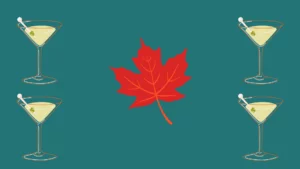
The Best Canadian Vodka
Canadian vodka is a unique spirit. Here are some of the best brands.
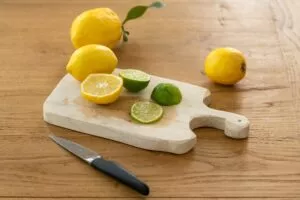
The Best Cutting Boards in Canada
You won’t have to sift through a mountain of cutting board reviews to find your perfect one.
